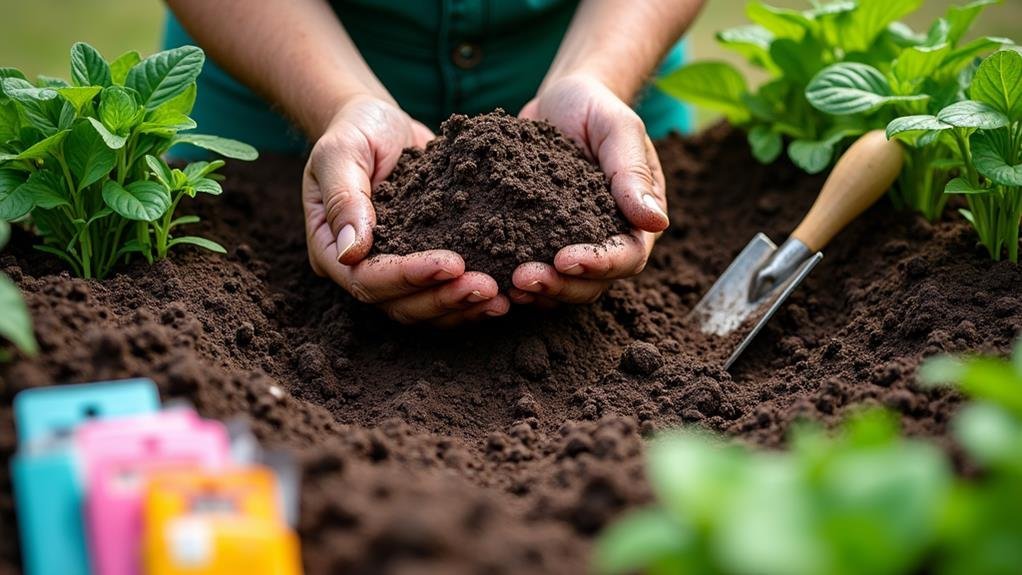When you think about creating a thriving garden, mulching often doesn't get the attention it deserves. Yet, it's one of the most effective strategies for enhancing soil health and boosting plant vigor. By choosing the right materials and applying them correctly, you can greatly improve moisture retention and suppress weeds. You might wonder what specific techniques can enhance your garden's performance. The answer lies in understanding the intricate details of mulching, and the first few strategies might surprise you. Let's investigate these essentials together.
Organic Mulch Benefits
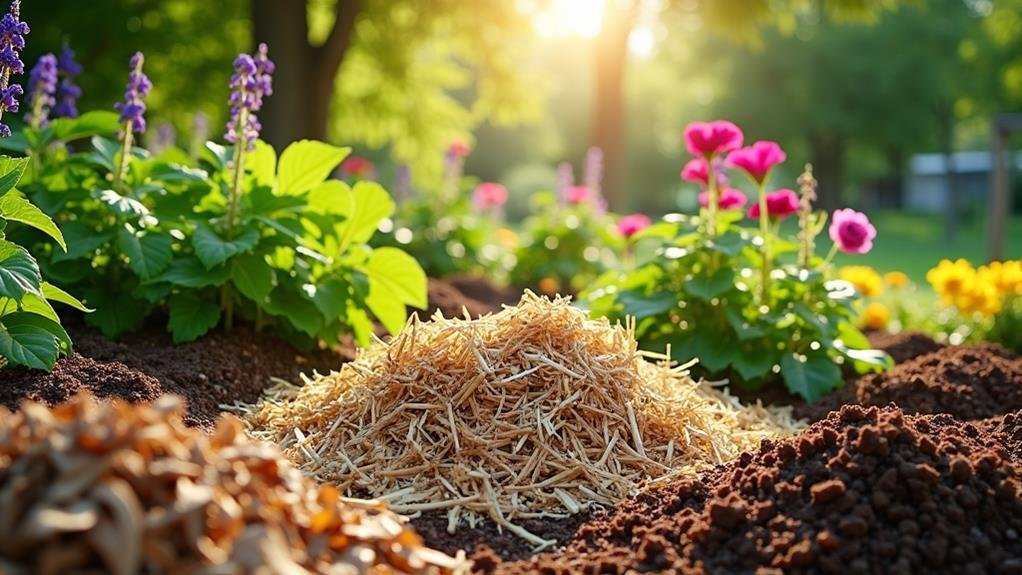
When you dig into organic mulch, you'll uncover a wealth of benefits for your garden. First off, it helps retain moisture in the soil, meaning less frequent watering for you. This is especially handy during those hot summer months when your plants are thirsty.
Plus, as the mulch breaks down, it feeds your soil with essential nutrients, promoting healthier plant growth.
Another key benefit is weed suppression. By blocking sunlight, organic mulch makes it harder for those pesky weeds to take root. You'll spend less time battling unwanted plants, allowing you to focus on nurturing your garden instead.
Additionally, organic mulch can improve soil structure over time, enhancing aeration and drainage. This creates a better environment for your plants to thrive.
You'll also find that organic mulch can help regulate soil temperature, keeping it cooler in the summer and warmer in the winter. This stability can be vital for the overall health of your plants.
Choosing the Right Material
Selecting the right material for your mulch is key to maximizing its benefits. Different materials offer unique advantages, so you'll want to reflect on your garden's specific needs.
Organic options, like wood chips, straw, or grass clippings, break down over time, enriching your soil with nutrients. If you're aiming for a more decorative touch, colored or shredded bark can improve the visual appeal of your garden while still providing insulation for your plants.
On the other hand, inorganic mulches, such as gravel or plastic, can be effective for weed control and moisture retention, but they don't offer any nutritional benefits. If you're in a dry climate, contemplate using a thick layer of organic mulch to keep the soil moist and cooler.
Think about your local climate and the types of plants you're growing, as some materials work better in certain conditions.
Also, reflect on the availability and cost of materials, as you'll want something that fits your budget.
Ultimately, the right mulch material can make a significant difference in your garden's health and appearance, so choose wisely!
Layering Techniques

Effective layering techniques can greatly improve the benefits of your mulch. Start by laying down a base layer of coarse materials, like small branches or wood chips. This allows for better drainage and air circulation, which are vital for root health.
Over this, add a layer of organic matter, such as leaves or straw. This not only enriches the soil as it breaks down but also retains moisture effectively.
Next, consider adding a weed barrier, like cardboard or newspaper, beneath your top layer of mulch. This will help suppress weeds without introducing harmful chemicals.
Once that's set, apply your final layer of mulch, such as bark or shredded leaves. Aim for a thickness of about three inches; this helps maintain soil temperature and moisture levels.
Remember to leave space around plant stems to prevent rot.
With these layering techniques, you'll create a more effective mulch system that promotes healthy plant growth. Plus, your garden will look tidy and inviting!
Timing Your Mulching
Timing your mulching can make a significant difference in your garden's health and productivity. You'll want to apply mulch at the right moments to maximize its benefits.
Ideally, mulch should be applied in early spring, once the soil has warmed up but before the weeds start sprouting. This timing helps suppress those pesky weeds and retain moisture for your plants as they begin to grow.
If you missed the spring window, applying mulch in the fall can also be beneficial. This layer will protect your soil from harsh winter conditions, reduce erosion, and maintain soil temperature. Just make certain to wait until after the first frost, so your plants are well-prepared for winter.
When you do mulch, make sure it's at least two to three inches thick, but avoid piling it against the stems of your plants—this can lead to rot.
Regularly check your mulch layer and consider timing your reapplication in accordance with seasonal changes, as this can boost the overall health of your garden.
Maintaining Mulch Layers
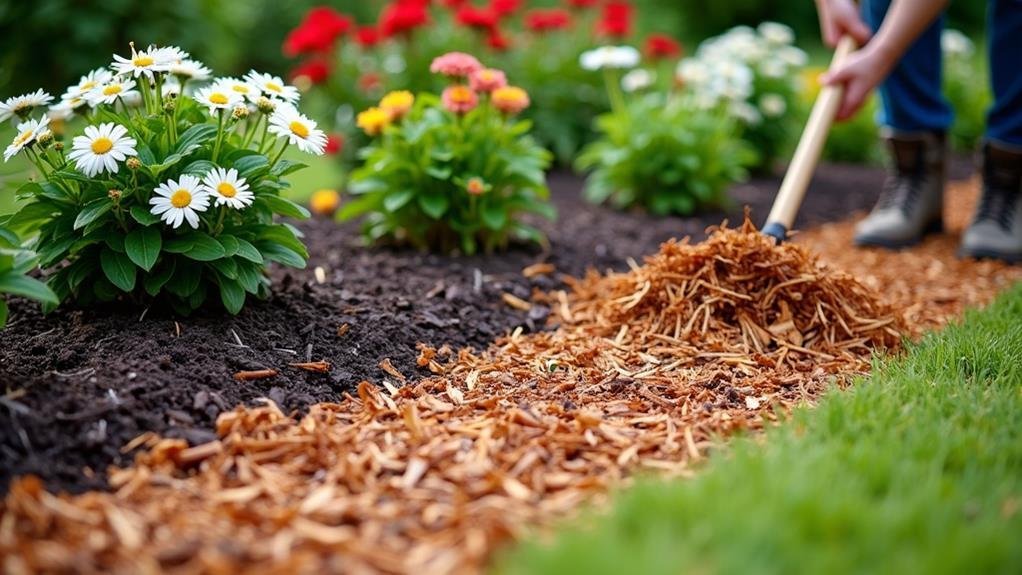
Maintaining your mulch layers is essential for sustaining a healthy garden ecosystem. Over time, mulch can break down or become compacted, reducing its effectiveness in moisture retention and temperature regulation.
To keep your mulch in top condition, regularly check its thickness and texture. Ideally, you want a layer of about two to four inches, which provides adequate coverage while allowing air and water to reach the soil.
As you inspect your mulch, look out for any signs of decomposition. If your mulch starts to look too thin or breaks down considerably, it's time to refresh it. Simply add a new layer to maintain that ideal thickness.
Additionally, be mindful of any weeds or debris that might accumulate on top. It's a good idea to clear away any organic matter that could attract pests or promote mold growth.
If you notice any issues, like compacted sections, fluffing up the mulch with a rake can help restore air circulation.
Mulching for Weed Control
While keeping your mulch layers in check is important for overall garden health, they also play a significant role in controlling weeds. A thick layer of mulch, typically around three inches, creates a barrier that blocks sunlight, preventing weed seeds from germinating. This means fewer weeds competing with your plants for nutrients and water.
Using organic mulches, like wood chips or straw, not only suppresses weeds but also breaks down over time, enriching your soil. Just be cautious with the type of mulch you choose—some, like grass clippings, can compact and form a mat, making it harder for water to penetrate.
Regularly inspect your mulch to verify it's thick enough. If you spot any weeds breaking through, pull them out promptly to stop them from spreading.
You might even consider adding a layer of landscape fabric beneath the mulch for extra protection against stubborn weeds.
Enhancing Soil Moisture
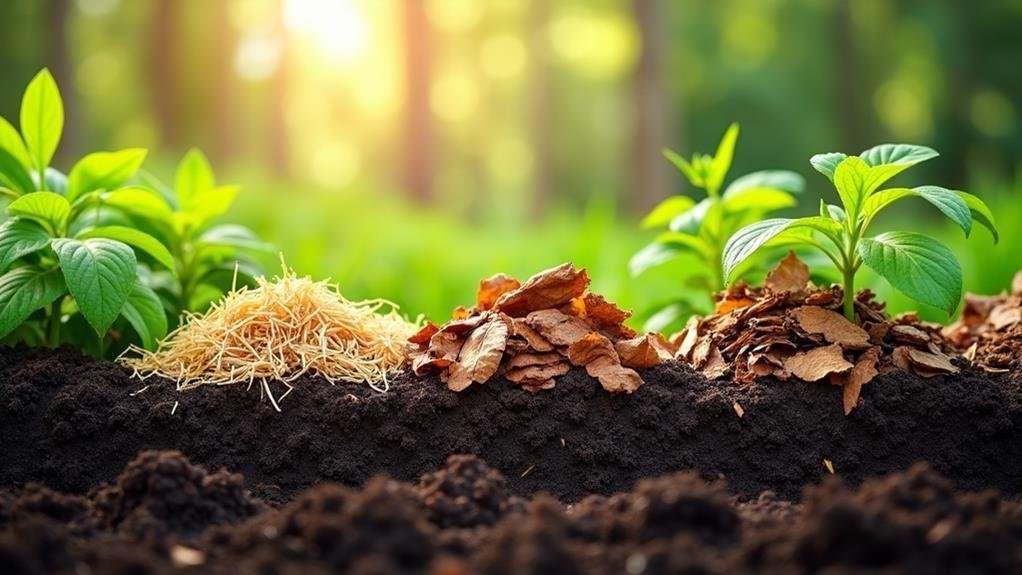
A well-chosen mulch can greatly improve soil moisture retention in your garden. By covering the soil, mulch acts as a barrier against evaporation, keeping moisture locked in and helping your plants thrive.
You'll find that organic mulches, like wood chips, straw, or shredded leaves, are particularly effective. They not only conserve moisture but also break down over time, enriching your soil with valuable nutrients.
When applying mulch, aim for a layer about 2 to 4 inches thick. This depth strikes a balance between retaining moisture and preventing water from pooling. Be certain to keep mulch a few inches away from plant stems to avoid rot.
Remember, the type of mulch you choose can make a difference. For instance, some materials, like pine needles, have a higher acidity level, which can be beneficial for certain plants but may not suit others.
Lastly, don't forget to refresh your mulch annually. Over time, it can break down and lose its effectiveness, so topping it up guarantees your garden continues to enjoy the moisture benefits.
A little effort goes a long way in creating a thriving, hydrated garden.
Improving Soil Temperature
Using mulch effectively can greatly improve soil temperature in your garden. It acts as a protective layer, shielding the soil from extreme temperatures. In the warmer months, a layer of mulch helps keep the soil cooler, reducing heat stress on plants.
Conversely, during colder months, mulch insulates the soil, preventing it from freezing too quickly.
When you choose the right type of mulch, consider its color and material. Darker mulches absorb heat, which can be beneficial for heat-loving plants like tomatoes. On the other hand, lighter-colored mulches reflect sunlight and keep the soil cooler, ideal for plants that prefer a bit more shade.
Applying mulch to your garden beds also reduces soil temperature fluctuations, creating a more stable environment for your plants. This stability promotes healthy root development and helps your plants thrive.
Aim for a layer of about 2 to 4 inches to maximize these benefits.
Nutrient-Rich Mulching Options
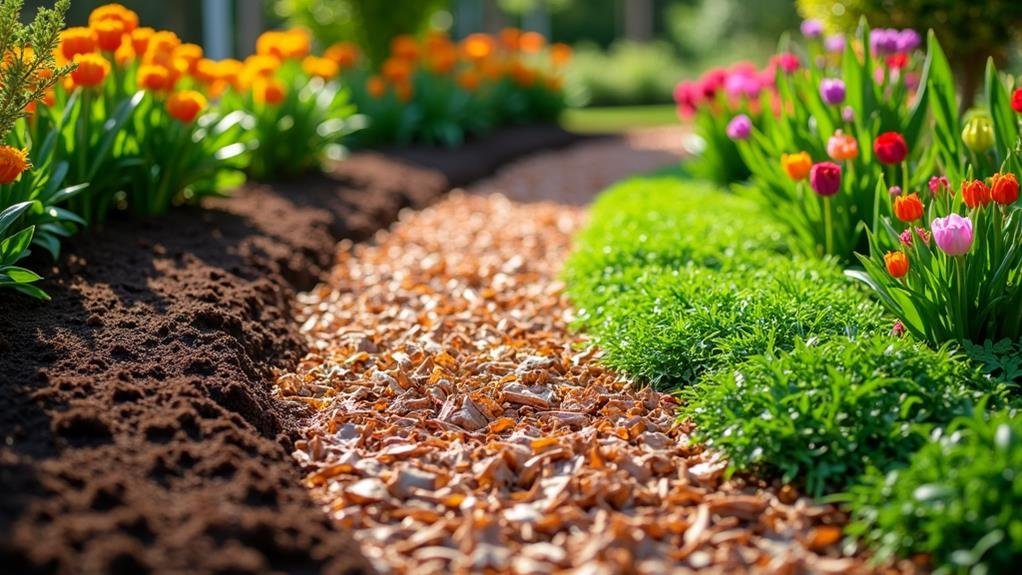
Choosing the right mulch not only helps regulate soil temperature but can also improve nutrient availability in your garden. Organic mulches, like shredded leaves, straw, or grass clippings, are excellent choices. As they break down, they release essential nutrients back into the soil, enriching it for your plants.
Compost is another fantastic option. By using well-decomposed compost as mulch, you're adding a nutrient powerhouse that promotes healthy plant growth. Plus, it helps retain moisture and suppress weeds, making it a double win.
Wood chips or bark can also be beneficial, especially when mixed with nitrogen-rich materials. They'll decompose slowly, providing a steady release of nutrients over time.
If you're looking for something a bit different, consider using seaweed or fish emulsion as a liquid mulch. These options are packed with trace minerals that nourish your plants.
Ultimately, the key is to select a mulch that not only fits your garden's aesthetic but also contributes to its health. So, get mulching, and watch your garden thrive with the right nutrient-rich choices!
Mulching in Different Seasons
Throughout the year, your mulching strategies should adapt to the changing seasons to maximize benefits for your garden.
In spring, apply a light layer of organic mulch to retain moisture and suppress weeds as plants begin to grow. This helps create a warm, inviting environment for seedlings.
As summer heats up, consider using a thicker layer of mulch. Materials like straw or wood chips can keep the soil cool, reducing evaporation and preventing plant stress.
Just make sure to refresh your mulch periodically, as it can break down faster in warmer weather.
When fall arrives, it's time to prepare for winter. You can use leaves or pine needles as mulch to insulate your plants and protect them from frost.
This layer keeps the soil temperature more stable, which is essential during cold snaps.
Conclusion
By implementing these top mulching strategies, you can greatly boost your garden's health and liveliness. Remember to choose the right materials and maintain your mulch layers for maximum effectiveness. Adjust your approach with the seasons, ensuring your plants get the moisture and nutrients they need. With a little effort and attention, you'll create a thriving garden that flourishes throughout the year. So grab your mulch and get started on this rewarding journey! To further enhance the benefits of mulching, consider incorporating natural pest control for indoor herbs. Utilize companion planting with herbs such as basil, mint, and lavender to naturally deter pests and promote a healthy herb garden. This combined approach will create a harmonious and thriving environment for all your plants.



